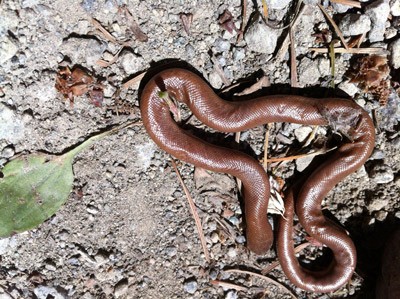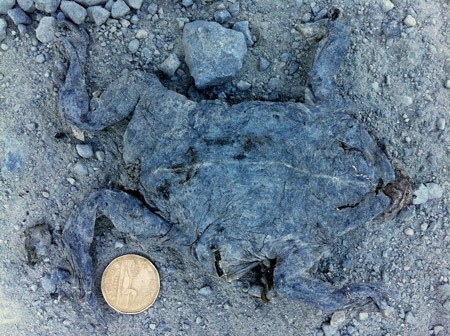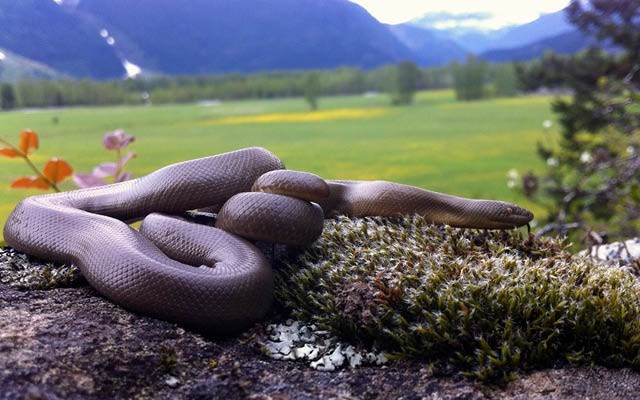It's spring, and young folks' fancies in Whistler rightly turn to love... and mountain biking.
Of course humans aren't the only animals that mate in spring, and the habits around that behaviour have an interesting relationship to our other spring preoccupation.
Like roadways, mountain-bike trails can become death zones for migrating reptiles and amphibians, some of which are already endangered and threatened species. So here's the dirt on what's out there in the spring-to-summer season and how you can avoid making things messier (so to speak) — and maybe even help a local conservation group with sightings.

Rubber Boa
To begin, Whistler doesn't have as many species as nearby Squamish and Pemberton, both of which also host earlier thaws that attract mountain bikers like spring robins, so most bike-meets-critter problems occur in these places.
Second, although most of these animals are rarely seen, in spring they aggregate for breeding in various places for mating. Generally salamanders and toads and some frogs overwinter in, or near, valley bottom wetlands. Then, after migrating to ditches, ponds and slow streams to mate and lay eggs, slowly disperse away into cooler forest and upland foraging habitat.

Because they're going up and away from water, they often cross the things humans like to build along watercourses — railroads, roads, trails. But because amphibians (excepting toads) generally have moist semi-permeable skin, they pretty much confine their immigration/emigration to rain events, and even then mostly at night when predators won't see them.
Unless you're riding under these conditions you won't threaten too many amphibians. Still, south of Whistler and in the extreme ends of the Pemberton Valley its possible to encounter land-loving adult Red-legged frogs (an endangered species in B.C.) and Western Toads — a threatened species — more than a few of which are pancaked on both roadway and mountain bike trails each spring.
It makes sense, then, to keep your eyes on the ground around wetlands.

Dead baby Rubber Boa on "Happy Trail" where it intersects Pemberton Farm Rd.
Another reason for doing so involves the snake fauna, particularly populous and diverse in Pemberton. Snakes spend winter in hillside dens on south-facing slopes, mating there in the warm days of May, then transiting to the valley floor for the summer. The area around wetlands is particularly busy because many snakes feed there — on the same amphibians you're trying to avoid squashing (another, albeit pyrrhic, reason for doing so).
In fact, gartersnakes are a major mechanism of energy transfer between aquatic and terrestrial ecosystems, especially in river valleys spotted with remnant wetlands. It goes like this: solar energy blooms algae in the water, tadpoles eat the algae, transform into frogs that consume enormous numbers of insects, snakes eat the frogs, and then birds and a few carnivorous mammals eat the snakes. Why would you want to get in the way of that?

Road killed Valley Gartersnake, Pemberton
In spring and summer in both Squamish and Pemberton you'll encounter gartersnakes coming and going between wetlands and forest or rocky hillsides for a few hours every morning and late afternoon. These are the major times they get squished, so be on the look out.
And though garternsnakes are numerous and not in need of conservation, abundance can decrease with mortality pressure; in Pemberton, the Mackenzie Forest Service Road that's so popular for bike drops sees numerous dead gartersnakes and alligator lizards (another common insect-munching species) littering the lower portion between the railroad tracks and the first big hill every day in the summer.
That's why you'll notice "Brake for Snakes" signs for vehicles and cyclists on the way in and on the old Pemberton Farm Road running along the base of the hillside.
When it comes to snake hazards, however, the biggest problem is a tricky one to solve, though awareness is again the best tool for conservation.
Although it's a species of "special concern" in B.C. because of widespread habitat loss, the primitive Rubber Boa is, for the moment, common in Pemberton; good thing, too — if it weren't for that the valley would have a genuine rodent problem. Olive- to dark-brown above, the boa rarely exceeds a half-metre in length and literally looks, feels and acts like a piece of rubber. It has tiny, lustrous scales, a small head with reduced eyes and vertical pupils, and a short, stubby tail — hence the folk name "two-headed snake."

Large bike-mutilated Wandering Gartersnake on Mackenzie Forest Service Rd.
The blunt tail is used to distract female rodents in their nests while the head is busy sucking down the young. The tail is often scarred due to rodent bites, noticeable when the timid animal is disturbed: it coils into a ball, sticks up the tail and waves it around.
Despite it's constrictor pedigree, however, the boa is harmless and never, ever bites. This secretive semi-burrower is active only at dusk and nocturnally in summer, but occasionally seen abroad on warm, cloudy days in spring — usually crossing trails on its way from hillside dens to the rodent-ridden grass- and cropland of the valley bottom. A few bracelet-like young are live-born sometime in July or August; they're pink or orange-ish in colour and look more like worms; being small, tough to see and coloured like vegetation means they're particularly vulnerable to unintentional squashing.
Knowing when you might see rubber boas helps: early morning rides are particularly snakey in this regard.
Lastly, although it's rarely if ever seen abroad, these same dry, south-facing, open-canopy hillsides that make for such great mountain biking are also perfect for the tiny (30 cm max), ultra-secretive, egg-laying Sharp-tailed Snake, a federally and provincially endangered species discovered in Pemberton in 2011 (the only mainland population in the province), and currently under threat from large-scale developments planned for these hillsides.

Large road-killed adult Western Toad in Upper Lillooet River area of Pemberton Valley
The problem with Sharp-tails — and boas to some extent — is that they hide under rocks and logs on these hillsides, so riding off-trail can kill them without you even knowing. Ditto for building trails without consulting organizations like Stewardship Pemberton (stewardshippemberton.com) that study these animals and can advise on proper trail placement in delicate habitats.
And finally, if you see any creatures out there, even if they are accidentally squashed, take a photo and send it to the local conservation organization — distribution data is another key to conservation.




